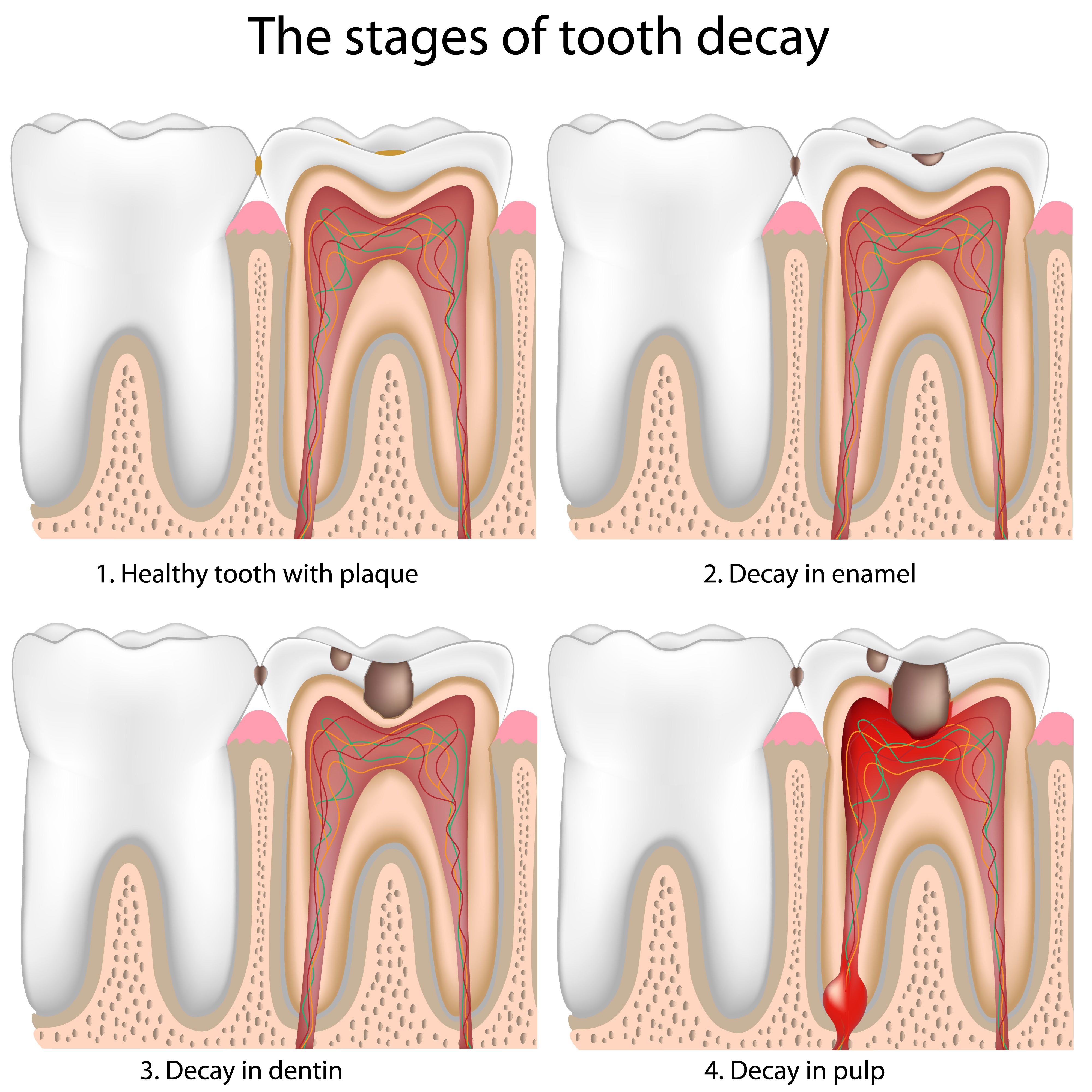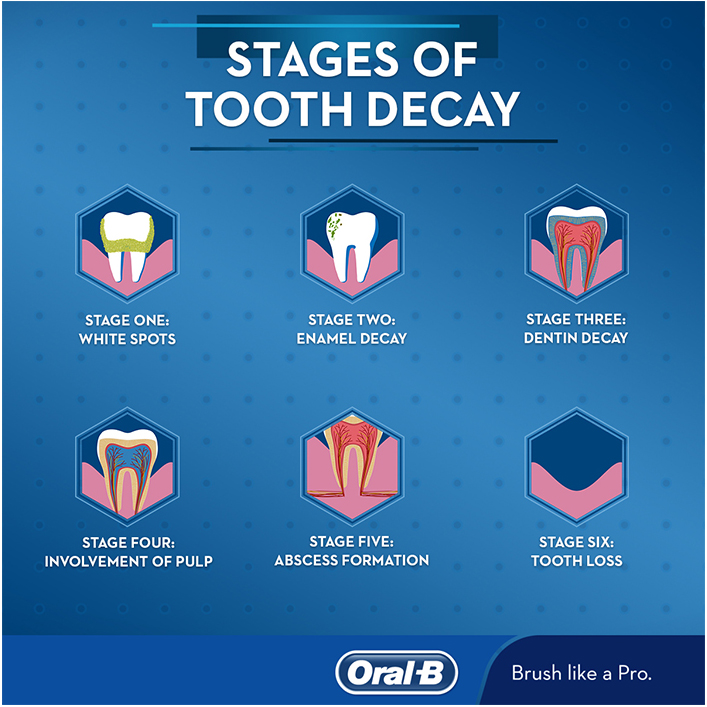Tooth decay progresses in stages, starting with the formation of a small cavity and eventually leading to tooth loss. In the initial stage, bacteria in the mouth produce acids that attack the tooth enamel, resulting in the formation of a cavity.
If left untreated, the decay can progress to the dentin, the inner layer of the tooth, causing increased sensitivity and pain. Eventually, the decay reaches the pulp, where the nerves and blood vessels are located, leading to severe pain and potential abscess formation.
The final stage involves the destruction of the tooth structure, leading to tooth loss and the need for restorative dental treatments like implants or dentures. Proper oral hygiene and regular dental visits are crucial in preventing and managing tooth decay.

Credit: www.okutandental.com
Stage 1: Early Signs Of Tooth Decay
In the early stages of tooth decay, you may notice the appearance of white spots on your teeth. These spots are indicative of the demineralization of the enamel, which is the outer layer of your teeth. The demineralization occurs due to the acid-producing bacteria in your mouth that feed on sugars and produce acids as byproducts. These acids attack the enamel, causing it to lose minerals and form white spots. Another early sign of tooth decay is sensitivity to hot or cold foods. When the enamel is compromised, the underlying dentin becomes exposed, leading to heightened sensitivity. The nerves in your teeth become more susceptible to temperature changes, causing discomfort or pain when consuming hot or cold foods and beverages.

Credit: www.blakeneysmiles.com
Stage 2: Decay Progression
| Stage 2: Decay Progression |
| Subheading: Formation of Cavities |
|
Tooth decay is a gradual process that occurs in multiple stages. In Stage 2, decay progression, the formation of cavities takes place. As bacteria feed on sugars and starches present in food, they produce acids that attack the tooth enamel. Over time, this acid erosion leads to the creation of small holes or cavities in the tooth’s structure. Increased tooth sensitivity is one of the early signs experienced during this stage. The dentin beneath the enamel becomes exposed, causing sensitivity to hot or cold temperatures, sweet or acidic foods or beverages, and even cold air. Another symptom is pain or discomfort while eating, particularly when biting down on food or applying pressure to the affected tooth. If left untreated, tooth decay can progress further and result in more severe dental issues. It is crucial to maintain good oral hygiene, visit your dentist regularly, and address any signs of tooth decay promptly to prevent further damage. |
Stage 3: Advanced Decay
Tooth decay is a common dental problem that progresses through different stages if left untreated. Stage 3 of tooth decay is known as advanced decay, and it can bring about various symptoms and visible signs. Deep cavities are a major characteristic of this stage, where the decay has reached the inner layers of the tooth. This can lead to severe toothache, as the decay reaches the nerves and blood vessels within the tooth. Additionally, individuals may notice visible holes in their teeth, indicating that the structure of the tooth has been compromised.
Treatment Of Tooth Decay
Tooth decay is a common dental problem that affects people of all ages. If left untreated, it can lead to pain, infection, and even tooth loss. Fortunately, there are several treatments available to combat tooth decay and restore oral health.
Fluoride Treatment
Fluoride treatment is an effective way to prevent and treat tooth decay. It involves the application of fluoride to the teeth, which strengthens the enamel and makes it more resistant to acid attacks. This treatment is particularly beneficial for children and adults who are at a high risk of developing cavities.
Dental Fillings
Dental fillings are commonly used to treat tooth decay. During this procedure, the decayed portion of the tooth is removed, and a filling material, such as composite resin or amalgam, is used to fill the cavity. Fillings restore the shape and function of the tooth, preventing further decay.
Root Canal Treatment
In cases where tooth decay has progressed to the innermost layer of the tooth, a root canal treatment may be necessary. This procedure involves removing the infected pulp, cleaning the root canal, and sealing it to prevent further infection. Root canal treatment saves the affected tooth and eliminates the need for extraction.
Prevention And Care
Tooth decay goes through several stages, starting with the development of a small cavity and progressing to more severe damage. Prevention and careful dental care are essential to catch decay in the early stages and avoid more extensive treatments down the line.
Keep your teeth healthy by practicing good oral hygiene and visiting your dentist regularly for check-ups.
Regular Brushing And Flossing
Maintaining a dedicated routine of brushing and flossing is crucial for preventing tooth decay. Brush your teeth twice daily using a soft-bristled toothbrush and a fluoride toothpaste. Gently brush every surface of your teeth using small circular motions, and don’t forget to clean your tongue as well. Flossing at least once a day helps to remove plaque and prevent cavities from forming between your teeth. Be sure to use proper technique when flossing, gently guiding the floss between each tooth and scraping along the sides to remove debris.
Dietary Changes
Making smart dietary choices can play a big role in preventing tooth decay. Reduce your consumption of sugary and acidic foods that can erode tooth enamel. Opt for a balanced diet rich in fruits, vegetables, and calcium-rich foods such as dairy products. Chewing sugar-free gum after meals can also help stimulate saliva production, which neutralizes acids and helps clear away food particles. Remember to drink plenty of water, as it can wash away bacteria and keep your mouth hydrated.
Regular Dental Check-ups
Regular visits to the dentist are crucial for maintaining good oral health and catching early signs of tooth decay. Dentists can perform professional cleanings to remove stubborn plaque and tartar buildup, as well as detect cavities and recommend appropriate treatments. X-rays may be taken to identify hidden decay between teeth. It is recommended to schedule a dental check-up at least twice a year. Remember, prevention is always better than cure when it comes to tooth decay!

Credit: oralb.com
Frequently Asked Questions On Stages Of Tooth Decay
How Do You Know What Stage Of Tooth Decay You Have?
To determine the stage of tooth decay, a dental examination is necessary. A dentist will assess the appearance of your teeth, use dental probes to check for soft spots, and may also take X-rays to detect decay between teeth or under fillings.
How Do I Know How Bad My Tooth Decay Is?
To determine the severity of tooth decay, consult a dentist who can examine your teeth and conduct X-rays. Dentists can accurately assess the extent of decay and recommend appropriate treatment. Regular dental check-ups are recommended to detect and address decay early.
At What Stage Does A Cavity Start To Hurt?
A cavity starts to hurt when it reaches the dentin layer (the layer underneath the enamel).
What Does Early Signs Of Tooth Decay Look Like?
Early signs of tooth decay include white spots on the teeth, sensitivity to hot and cold, toothache, and bad breath.
What Are The Early Signs Of Tooth Decay?
Early signs of tooth decay include tooth sensitivity, mild toothache, and white spots on the surface of the teeth.
How Does Tooth Decay Progress?
Tooth decay progresses in stages: from the formation of dental plaque and cavities to the destruction of tooth enamel, dentin, and eventually reaching the tooth’s pulp.
Can Tooth Decay Be Reversed Naturally?
Tooth decay can be reversed in its early stages with proper dental hygiene practices, such as brushing twice a day, flossing, and using fluoride toothpaste.
Conclusion
To wrap up, understanding the stages of tooth decay is vital for maintaining good oral health. From the initial formation of plaque to the eventual decay of the tooth structure, each stage requires attention and proactive measures. Regular dental check-ups, proper oral hygiene practices, and a balanced diet can help prevent and treat tooth decay effectively.
By staying informed and proactive, you can ensure a healthier, brighter smile for years to come. Take charge of your dental health today!




